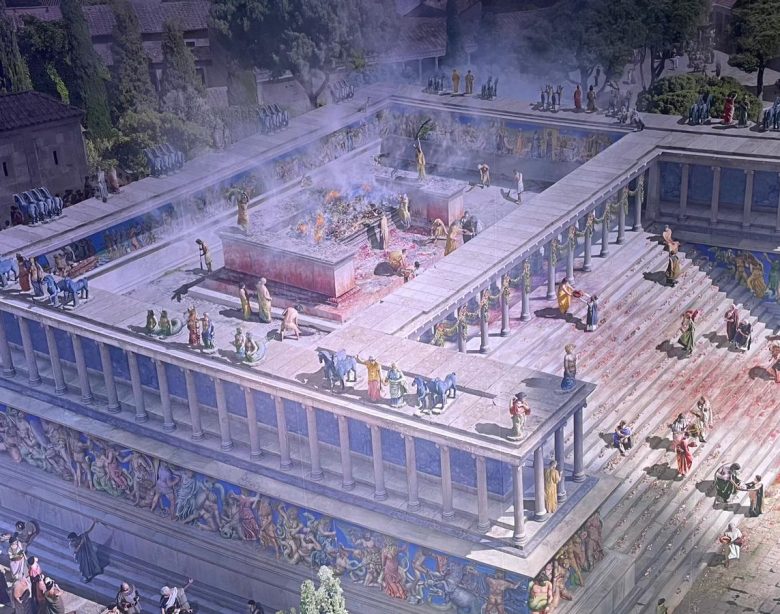Today we continue with a new part of our series on Hellenistic cities: Pergamon. This was an ancient city located in modern-day Turkey, which played a significant role in the political and cultural landscape of the Hellenistic period. The city’s strategic location, powerful rulers, and impressive monuments made it a major player in the Hellenistic world.
Politically, Pergamon was ruled by the Attalid dynasty, who came to power in the third century BC after rebelling against king Lysimachos. Under the Attalids, Pergamon became a strong and wealthy kingdom, rivaling the other Hellenistic powers such as the Seleucid and the Ptolemaic Kingdoms. The Attalids were able to expand their territory through military conquests and alliances with other city-states.
 The city of Pergamon was a major center of culture and learning of the Hellenistic world. The city was home to a vibrant community of scholars, philosophers, and artists. The famous Library of Pergamon, which was said to contain over 200,000 scrolls, was one of the most important libraries of the ancient world and rivaled that of Alexandria. The city also had a thriving theater scene, with the Pergamon Theater being one of the largest and most impressive of its time as it had room for around 10,000 spectators.
The city of Pergamon was a major center of culture and learning of the Hellenistic world. The city was home to a vibrant community of scholars, philosophers, and artists. The famous Library of Pergamon, which was said to contain over 200,000 scrolls, was one of the most important libraries of the ancient world and rivaled that of Alexandria. The city also had a thriving theater scene, with the Pergamon Theater being one of the largest and most impressive of its time as it had room for around 10,000 spectators.
One of the most notable monuments in Pergamon is the Pergamene Altar, a massive structure dedicated to the god Zeus. The altar was built in the 2nd century BC and is considered one of the greatest examples of Hellenistic art and architecture. The altar features a series of sculptural friezes depicting the battle of the Giants and the Olympians, which are considered some of the finest examples of Hellenistic sculpture. The altar also had a massive stairway leading up to the main platform, which would have been used for religious ceremonies and sacrifices.
 Another important monument in Pergamon is the Asclepion, a sacntuary dedicated to the god Asclepius. The Asclepion was a place where people would come to seek treatment for their illnesses and injuries. The Asclepeion was said to have been equipped with a variety of facilities, including a gymnasium, a theater, and a library. The Asclepion was also known for its dream incubation, a practice where people would sleep in the temple in the hope that Asclepius would appear to them in a dream and offer a cure for their ailment.
Another important monument in Pergamon is the Asclepion, a sacntuary dedicated to the god Asclepius. The Asclepion was a place where people would come to seek treatment for their illnesses and injuries. The Asclepeion was said to have been equipped with a variety of facilities, including a gymnasium, a theater, and a library. The Asclepion was also known for its dream incubation, a practice where people would sleep in the temple in the hope that Asclepius would appear to them in a dream and offer a cure for their ailment.
In Pergamon, the houses of the Hellenistic period followed the broader trends of the time, with variations based on social class and regional influences.. One notable example of Hellenistic residential architecture in Pergamon is the House of Dionysus. This grand house was likely built in the 2nd century BCE and features a central courtyard, multiple levels, and impressive architectural details such as Ionic columns and decorative friezes. The house also had a private bathhouse and a hypocaust system for heating. Other examples of residential architecture in Pergamon include smaller houses and apartments, which would have been occupied by the lower and middle classes. These structures were likely more modest in scale and design, but still incorporated some of the stylistic elements of the grander houses.
Pergamon was an important city during the Hellenistic period. The city’s political power, cultural achievements, and impressive monuments make it a significant player in the Hellenistic world. The Pergamene Altar and Asclepion are just two examples of the many architectural and artistic achievements of the city and are considered masterpieces of Hellenistic art and architecture. The history of Pergamon offers a glimpse into the vibrant and diverse world of the Hellenistic period, showcasing the political and cultural achievements of the city and its people.
Further reading:
Bundgaard, J. A. (1995). Pergamon: Citadel of the Gods. Yale University Press.
Dreyfus, R., & Schraudolph, E. (1996). Pergamon: The Telephos Frieze from the Great Altar. University of Texas Press.
Drew-Bear, T. (2015). Pergamum: A Byzantine Capital in Asia Minor. Routledge.
Haselberger, L. (2001). The Pergamon Altar: Its Rediscovery, Reconstruction, and Influence on American Museums. Harvard University Press.
Picón, C. A., & Hemingway, S. (2016). Pergamon and the Hellenistic Kingdoms of the Ancient World. Metropolitan Museum of Art.




